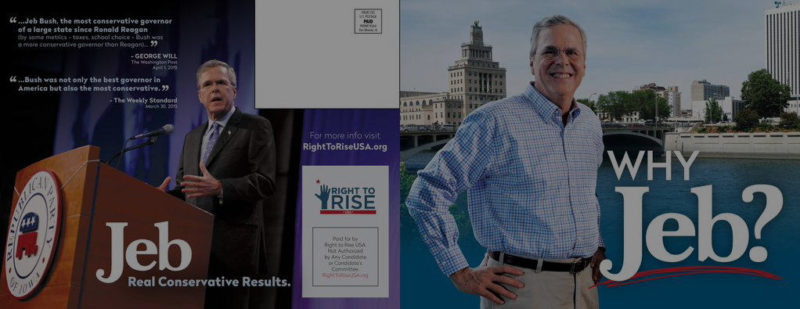With one Republican Presidential Primary Debate already behind us, election season is in full swing. With the unlimited fundraising capabilities brought about by Citizens United, Super PACs have started unleashing a barrage of advertisements that prominently feature photography. Thus, it’s no surprise that we’ve already experienced the first major gaffe with Jeb Bush’s Right to Rise USA.
Last week, the Super PAC sent out a mailer featuring a composited photo of Bush in front of the Cedar Rapids riverfront. But all was not well in Cedar Rapids. As many people pointed out, it appeared as though Bush had black skin on his left hand.
um… photoshop much? https://t.co/1x2vYRMFSO pic.twitter.com/PpLsODFolz
— Zeke Miller (@ZekeJMiller) August 21, 2015
Speculation grew that Bush’s head had been Photoshopped onto the body of an African-American stock photography model. The truth, as explained by a Right to Rise USA spokesperson, was a bit less nefarious, but still sloppy.
Mysterious hand revealed. Meant to use Valencia. Fail. Not deleting it from our servers. pic.twitter.com/sczIMf1REx
— Paul Lindsay (@Paul_Lindsay) August 22, 2015
Contextual lighting issues echo the “What color is this dress?” debate from earlier this year. But the real issue has larger implications for political campaigns: namely, a lack of a visual strategy.
More images are being created and consumed than ever before. Organizations must learn to “speak” this visual language to a range of constituents while simultaneously maintaining their brand values and identity. Creating a Visual Strategy requires a new understanding and a new set of tools to manage the storage, access and distribution of images.
Does your campaign’s visual strategy include:
Guidelines not only include how the candidate should appear (e.g. always in a suit with a red tie), but also the types of photography that are appropriate.
- Even with recent advancements, cellphone photography lacks the clarity of images taken with professional equipment.
- Time of day and lighting conditions can also adversely the quality, and therefore the perception of images.
- The style of imagery affects the perception of authenticity. Do the photos make the candidate look approachable? Do they convey professionalism? Does everything look like a bad snapshot?
Thanks to supporters gathering early in Frankfort waiting for Rand to arrive at RPK meeting. pic.twitter.com/KofPpwG8m0
— Senator Rand Paul (@RandPaul) August 22, 2015
Visual guidelines are no different than a style manual for issuing press releases. You need one to maintain internal consistency while establishing a brand personality.
Campaign photo editor
Most campaigns are savvy enough to hire a staff photographer. Less likely is the employ of a professional photo editor. Photo editing, like film editing, is an art. The use of photography in a campaign is a storytelling device, and it’s unrealistic to assume that someone who hasn’t consumed and scrutinized vast quantities of photos will be well-equipped to determine the “value” of one photo over another. Seasoned photo editors have contemplated how to effectively tell a story through photos by culling through thousands of photos each day.
A good photo editor would have either never allowed the original Bush image to be used, or vetoed the masked image for the obvious lighting issue with the hand.
@Paul_Lindsay – Why even use that pic? You guys don’t have any other photos of Jeb alone smiling? Very amateur hour…..
— TCinOP (@TCinOP) August 23, 2015
Photo library of approved imagery
Like any organization, spending the time to create a photo library of approved imagery will pay dividends for any campaign. With access to a daily feed of photos and a throng of campaign staff and volunteers, it’s too easy for an unlicensed or unauthorized image to suddenly appear on social media or any other medium for that matter.
Using a photo editor to help create a photo library will ease the burden on marketing staff, and streamline the use of images within any campaign.
Campaigns are shaped as much by images as by words. With so much on the line, campaigns and the PACs that support them would be pennywise and pound foolish not to invest in creating and supporting a solid visual strategy.



